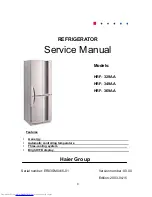
SERVICE MANUAL
Model
:
CHM11BPL3
;
8
Issue
2020-5-15
REV
Ref1607S002V0
R
e
v
.
R
e
f
1
1
0
1
S
0
0
4
V
0
Water may drip from the back flange of the lid cover during defrosting. This is normal. Ice
builds up in the lid insulation when the lid is open for adding or removing food, and melts during the
defrosting operation.
3-3 Cleaning the Freezer
Outside.
Protect the paint finish. The finish on the outside of the freezer is a high quality baked-on
paint finish. With proper care, it will stay new-looking and rust-free for years. Apply a coat of appliance
polish wax when the freezer is new and then at least twice a year. Appliance polish wax also works
well to remove tape residue from freezer surfaces.
Keep the finish clean.
Wipe with a clean cloth lightly dampened with appliance polish wax or mild
liquid dishwashing detergent. Dry and polish with a clean, soft cloth. Do not wipe the freezer with a
soiled dishwashing cloth or wet towel. Do not use scouring pads, powdered cleaners, bleach, or
cleaners containing bleach.
Inside.
Clean the inside of your freezer at least once a year. We recommend that the freezer be
unplugged before cleaning. If this is not practical, wring excess moisture out of sponge or cloth when
cleaning in the vicinity of switches, lights or controls.
Use warm water and baking soda solution-about a tablespoon of baking soda to a quart of water.
Rinse thoroughly with water and wipe dry. Do not use cleaning powders or other abrasive cleaners.
An open box of baking soda in the freezer will absorb stale freezer odors. Change the box ever y three
months.
Care should be taken in moving the freezer away from the wall. All types of floor coverings can
be damaged particularly cushioned coverings and those with embossed surfaces.
Summary of Contents for CHM11BPL3
Page 19: ...Sincere forever ...





































